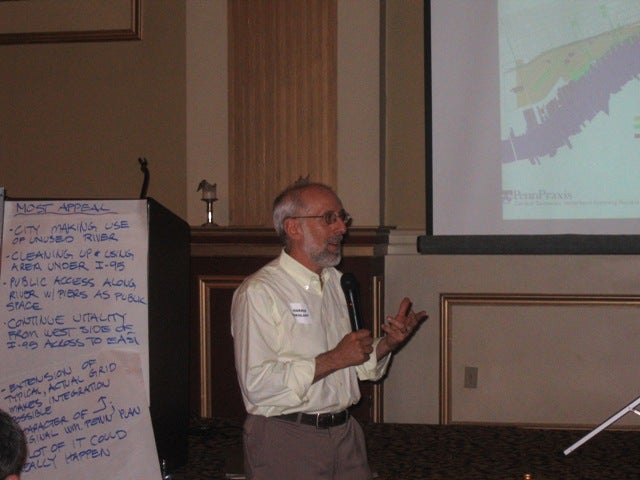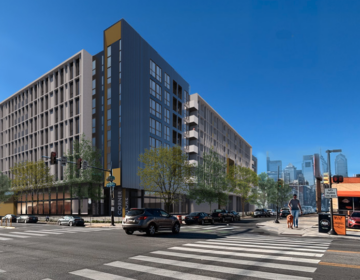A reflection of waterfront values

Aug. 1
By Alan Jaffe
For PlanPhilly
A diverse group of about 150 city residents and workers received a progress report on the plan to redevelop the seven-mile Central Delaware riverfront on Wednesday evening, and they responded with a characteristic dose of Philadelphia skepticism – but also a wave of optimism for the future of the waterfront.
The plan being coordinated by PennPraxis, the clinical arm of the design school of the University of Pennsylvania, reflects a new attitude for the city in which “the glass is half full” and there are “pristine possibilities,” said Ira Upin, a board member of the Northern Liberties Neighbors Association.
The presentation was held in the elegant Cescaphe Ballroom in Upin’s rapidly changing riverfront community. Many of the participants in the small-group discussions that followed the presentation were Northern Liberties residents, but others came from neighborhoods throughout the city to hear Penn Praxis executive director Harris Steinberg lay out the current state of the plan.
He explained that the proposals are the “refinement of ideas” born at a March design workshop attended by city planners and designers from around the country and the world. Civic engagement sessions since then have involved about 3,200 city residents expressing their ideas and values regarding the waterfront. But the new plan is also very much like the one drawn up by William Penn in 1692, based on a street grid, open spaces and development parcels that created a “livable, walkable city.”
“The goal here is to bring that street network down to the river’s edge,” Steinberg said.
The “vision plan” would carry the “infinite permutations that people love about Philadelphia on this side of I-95” down to the riverside through multi-use zoning and a “rich network of streets and open spaces that create new neighborhoods” on the Delaware, he explained. “This is really about William Penn’s grid coming to the river in a 21st century way.”
He also noted that the plan stakes out 1,000 acres of “a new Philadelphia” — about half the size of Center City now.
The audience divided itself into seven groups of 15 to 20 participants to respond to the proposals and offer their own. Harris Sokoloff, who leads the Penn Project on Civic Engagement, asked them to rise above the perception of the city as a nay-saying “Nega-delphia” and explore the opportunities the plan offers. Mostly, they obliged.
Nikki Thorpe, a recent transplant to the city, said that coming from landlocked Indianapolis made her appreciate the effort to “take advantage of the river.” And she welcomed the civic movement underway to determine how the waterfront will be remade. “Let’s get it right,” the Penn student said.
A resident of the new Waterfront Square condominium development, Donna Glickstein, grew up in the city, and she was impressed that the plans include green space along the water. The city’s children need a pleasant place to go in the urban environment, she said.
David Rosania, who moved from Northeast Philadelphia to Waterfront Square last October, was concerned that the Delaware River plans involved “too many splintered interests.” The success of the proposals will require getting “everyone on board,” Rosania said.
Other small-group participants doubted the feasibility of aspects of the plan because of costs and political hurdles. Some worried about higher property taxes that will accompany development and the erection of gated communities that would preclude access to the river.
But the plans presented by Steinberg mainly inspired an air of excitement in the ballroom. Despite the economic obstacles, many saw economic generators in the proposals. They saw new jobs, new public transit, new parks, new neighborhoods. Ximena Valle, a West Philadelphia resident who works in Center City, envisioned “a unique identity for the waterfront” that encompasses aspects of its past and present, including the industrial history.
Jesse Gardner, an urban designer who moved here from New York in 1995 and spurred the creation of the Liberty Lands Community Park in Northern Liberties, emphasized the upside of new taxes and new revenue for Philadelphia from the waterfront plans. The Penn Praxis effort is part of “a new energy in the city,” Gardner said. “The city is on upswing.”
Some participants tempered their enthusiasm with pragmatism, noting the need for zoning that ensures mixed uses along the waterfront and development in proportional scale. There were suggestions that if the proposal to sink part of I-95 isn’t possible, an alternative plan might be needed. And there were numerous suggestions that the waterfront planners enlist the support of developers, industry, public officials, and all the city residents who haven’t attended a PennPraxis workshop.
City resident Rene Goodwin warned that the plan would be “our last shot to get it right.” There are dwindling parcels that have not been developed along the water, and “the condo towers are coming,” she said. “This is a critical time. It is the last chance for reasonable development.”
WHYY is your source for fact-based, in-depth journalism and information. As a nonprofit organization, we rely on financial support from readers like you. Please give today.






